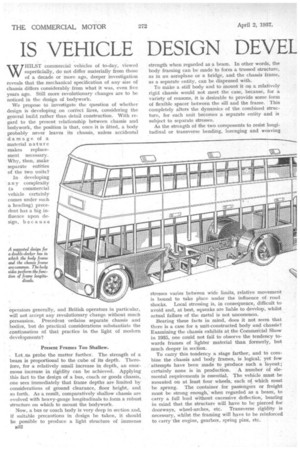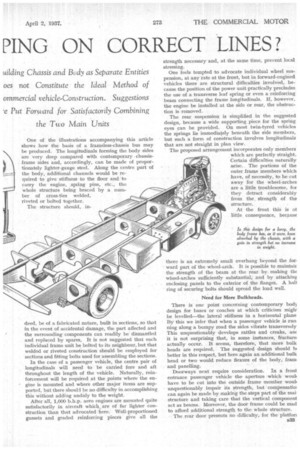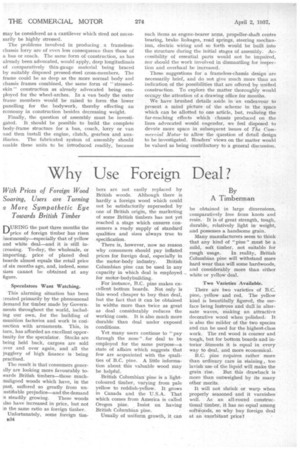IS VEHICLE DESIGN DEVEL PING ON CORRECT LINES?
Page 46

Page 47

Page 48

If you've noticed an error in this article please click here to report it so we can fix it.
gilding Chassis and Body as Separate Entities oes not Constitute the Ideal Method of ommercial vehicle-Construction. Suggestions .e Put Forward for Satisfactorily Combining
WHILST commercial vehicles of to-day, viewed superficially, do not differ materially from those of a decade or more ago, deeper investigation reveals that the mechanical specification of any size of chassis differs considerably from what it was, even five years ago. Still more revolutionary changes are to be noticed in the design of bodywork.
We propose to investigate the question of whether design is developing on correct lines, considering the general build rather than detail construction. With regard to the present relationship between chassis and bodywork, the position is that, once it is fitted, a body probably never leaves its chassis, unless accidental damage of a material nature makes replacement necessary. Why, then, make separate entities of the two units?
operators generally, and British operators in particular, will not accept any revolutionary change without much persuasion. Precedent ordains separate chassis and bodies, but do practical considerations substantiate the contrauation of that practice in the light of modern developments?
Present Frames Too Shallow.
Let, us probe the matter further. The strength of a beam is proportional to the cube of its depth. Therefore, for a relatively small increase in depth, an enormous increase in rigidity can be achieved. Applying this fact to the design of a bus, coach or goods chassis, one sees immediately that frame depths are limited by considerations of ground clearance, floor height, and so forth. As a result, comparatively shallow chassis are evolved with heavy-gauge longitudinals to form a robust structure on which to mount the bodywork.
Now, a bus or coach body is very deep in section and, if suitable precautions in design be taken, it should be possible to produce a light structure of immense B32 strength when regarded as a beam. In other words, the body framing can be made to form a trussed structure, as in an aeroplane or a bridge, and the chassis frame, as a separate entity, can be dispensed with.
To make a stiff body and to mount it on a relatively rigid chassis would not meet the case, because, for a variety of reasons, it is desirable to provide some form of flexible spacer between the sill and the frame. This completely alters the dynamics of the combined structure, for each unit becomes a separate entity and is subject to separate stresses.
As the strength of the two components to resist longitudinal or transverse bending, lozenging and weaving stresses varies between wide limits, relative movement is bound to take place under the influence of road shocks. Local stressing is, in consequence, difficult to avoid and, at best, squeaks are liable to develop, whilst actual failure of the metal is not uncommon.
Bearing these facts in mind, does it not seem that there is a case for a unit-constructed body and chassis? Examining the chassis exhibits at the Commercial Show in 1935, one could not fail to observe the tendency towards frames of lighter material than formerly, but much deeper in section.
To carry this tendency a stage farther, and to combine the chassis and body frames, is logical, yet few attempts have been made to produce such a layout; certainly none is in production. A number of elemental requirements is essential. The vehicle must be mounted on at least four wheels, each of which must be sprung. The container for pasSengers or freight must be strong enough, when regarded as a beam, to carry a full load without excessive deflection, bearing in mind that the structure will have to be pierced for doorways, wheel-arches, etc. Transverse rigidity is necessary, whilst the framing will have to be reinforced to carry the engine, gearbox, spring pins, etc. One of the illustrations accompanying this article shows how the basis of a frameless-chassis bus may be produced. The longitudinals forming the body sides are very deep compared with contemporary . chassisframe sides and, accordingly, can be made of proportionately lighter-gauge steel. Along the centre part of the body, additional channels would be re quired to give stiffness to the floor and to carry the engine, .spring pins, etc., the whole structure being braced by a number of cross-ties welded, riveted or bolted together.
The structure should, in
deed, be of a fabricated nature, built in sections, so that in the event of accidental damage, the part affected and the surrounding components can readily be dismantled and replaced by spares, It is not suggested that each individual frame unit be bolted to its neighbour, but that welded or riveted construction should be employed for sections and fitting bolts used for assembling the sections.
In the case of a passenger vehicle, the centre pair of longitudinals will need to be carried fore and aft throughout the length of the vehicle. Naturally, reinforcement will be required at the points where the engine is mounted and where other major items are supported, but there shoull be no difficulty in accomplishing this without adding unduly to the weight.
After all, 1,000 b.h.p. aero engines are mounted quite satisfactorily in aircraft which are of far lighter construction than that advocated here. Well-proportioned gussets and graded reinforcing pieces give all the strength necessary and, at the same time, prevent local stressing.
One feels tempted to advocate individual wheel suspension, at any rate at the front, but in forward-engined vehicles there are structural difficulties involved, because the position of the power unit practically precludes the use of a transverse leaf spring or even a reinforcing beam connecting the frame longitudinals. If, however, the engine be installed at the side Or rear, the obstruction is removed.
The rear suspension is simplified in the suggested design, because a wide supporting piece for the spring eyes can be provided. On most twin-tyred vehicles the springs lie immediately beneath the side members, but such a form of construction involves longitudinals that are not straight in plan view.
The proposed arrangement incorporates only members which are perfectly straight. Certain difficulties naturally arise.. The portions of the outer frame members which have, of necessity, to be cut away for the wheel-arches are a little troublesome, for they detract considerably from the strength of the structure.
At the front this is ot little consequence, because there is an extremely small overhang beyond the for. ward part of the wheel-arch. It is possible to maintair the strength of the beam at the rear by_ making thE wheel-arches sufficiently substantial, and by attaching enclosing panels to the exterior of the flanges. A hall ring of securing bolts should spread the load well.
Need for More Bulkheads.
There is one point concerning contemporary body design for buses or coaches at which criticism mighi be levelled—the lateral stiffness in a horizontal plane By this we infer that when a passenger vehicle is running along a bumpy road the sides vibrate transversely This unquestionably develops rattles and creaks, ant it is not surprising that, in some instances, fracture: actually occur. It seems, therefore, that more bulk heads are required. The suggested design should bi better in this respect, but here again an additional bulk head or two would reduce flexure of the body, frami and panelling.
Doorways next require consideration. In a front entrance passenger vehicle the aperture which wouk have to be cut into the outside frame member woul■ unquestionably impair its strength, but compensatioi can again be made 'by making the steps part of the mai. structure and taking care that the vertical component act as beams. Moreover, the door frame could be mad to afford additional strength to the whole structure.
The rear door presents no difficulty, for the platfori may be considered as a cantilever which freed not necessarily be highly stressed.
The problems involved in producing a framelesschassis lorry are of even less consequence than those of a bus or coach. The same form of-construction, as has already been advocated, would apply, deep longitudinals of comparatively thin-gauge material being braced by suitably disposed pressed-steel cross-members. The frame could be as deep as the more normal body and chassis frames combined, the same form of " stressedskin " construction as already advocated being employed for the wheel-arches. In a van body the outer frame members would be raised to form the lower panelling for the bodywork, thereby effecting an economy in construction besides decreasing weight.
Finally, the question of assembly must be investigated. It should be possible to build the complete body-frame structure for a bus, coach, lorry or van and then install the engine, clutch, gearbox and auxiliaries. The fabricated system of assembly should enable these units to be introduced readily, because such items as engine-bearer arms, propeller-shaft centre bearing, brake linkages, road springs, steering mechanism, electric wiring and so forth would be built into the structure during the initial stages of assembly. Accessibility of essential parts would not be impaired, nor should the work involved in dismantling for inspection and overhaul be increased.
These suggestions for a frameless-chassis design are necessarily brief, and do not give much more than an indication of the possibilities that are offered by unified construction. To explore the matter thoroughly would occupy the attention of a drawing office for months.
We have brushed details aside in an endeavour to present a mind picture of the scheme in the space which can be allotted to one article, but, realizing the far-reaching effects which chassis produced on the lines advocated would engender, we feel disposed to devote more space in subsequent issues of The Commercial Motor to allow the question of detail design to be investigated. Readers' views on the matter would be valued as being contributory to a general discussion.




























































































